According to the State of Michigan, the total number of COVID cases in Michigan rose to 53,510 on May 21, an increase of 501 cases from the previous day. This total was equivalent to 536 cases per 100,000 people (Chart 4). Of those 501 cases 155 were documented in Southeastern Michigan. This means that of the new daily COVID cases Southeastern Michigan accounted for 31 percent of them, highlighting how most of the new cases continue to occur outside of the region. The five-day rolling average for the total number of COVID cases (Chart 1) reflects a smoother curve and adjusts for fluctuations in testing and/or the quality of reporting or failure to report. While the curve is smooth, Chart 1 shows that number of cases in Michigan continues to increase, largely due to new cases reported outside of Southeastern Michigan.
Chart 2 shows that, based on the five-day rolling averages, the growth of new COVID cases in Southeastern Michigan continued to level off for the counties in region. The flattening of the COVID growth curves in Southeastern Michigan also further supports how the increase of COVID cases is slowing in the region, with cases outside the region now making up majority of the new daily COVID cases. On May 19 the number of cases in Detroit reached 10,438, the highest in the region, and Wayne County reported the second highest number of cases at 8,853. On May 19, the five-day rolling average for the number of COVID cases in Oakland County was 8,083, and Macomb County reported 6,376.
The City of Detroit had 1,570 COVID cases per 100,000 people on May 21, an increase from 1,561 the day before (Chart 3). This is based upon a reported increase of 59 new COVID cases, bringing the total number of COVID cases in Detroit to 10,558. Wayne County reported 834 cases per 100,000 people, and Oakland County had 646 cases per 100,000 people. These per capita rates were based upon 8,980 total cases for Wayne and 8,125 for Oakland. Macomb County reported 735 cases per 100,000 people, which is based upon 6,420 cases.
The daily data highlighted in these posts is from Michigan.gov/coronavirus, where data is updated daily at 3 p.m. Historical data were supplied from covidtracking.com, which republishes COVID data from the State. Additionally, the case totals do not reflect the number of people who have recovered, just those who have been infected.
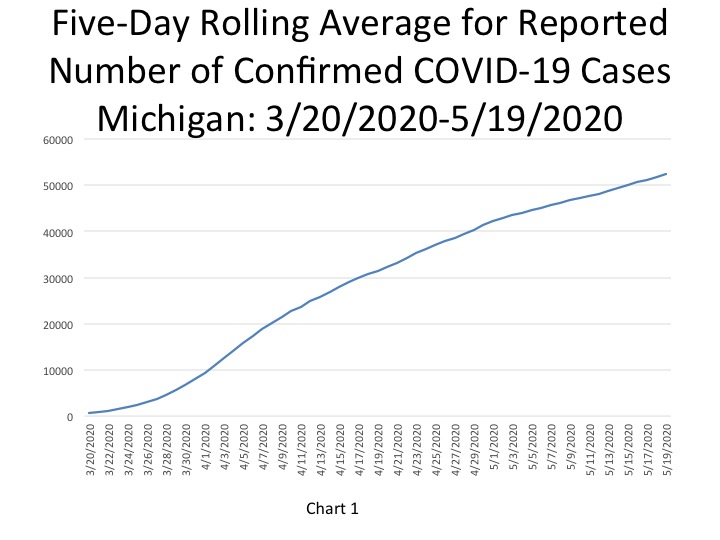
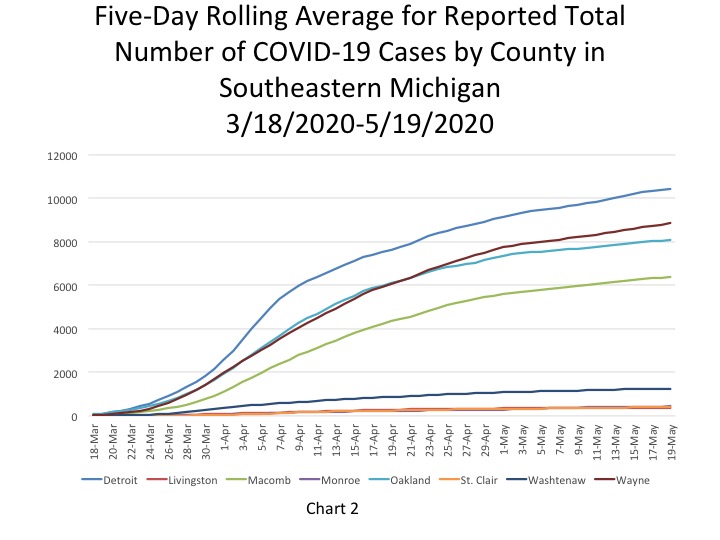
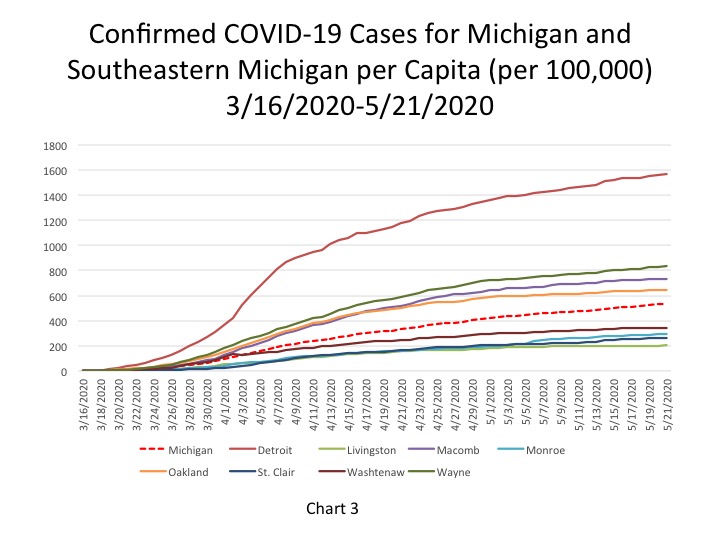
Chart 4 shows that Wayne County reported the highest number of daily cases at 58 on May 19, an increase of 2 daily cases from the day prior when it also had the highest number of daily cases. Overall, this chart shows that daily case numbers throughout Southeastern Michigan continues to decline, despite new daily COVID cases numbers at the State remaining above 500 total.
On May 21 the per capita rate for the number of new daily COVID cases per 100,000 people was 5 for the State; this was equivalent to 501 new cases. The number of new cases the State reported on May 21 was a decrease from the day before, but new daily numbers have only dropped below 500 once in the last week. Detroit was the only government entity in the region to report a higher per capita rate for the number of new daily COVID cases per 100,000 people than the State. On May 21 Detroit reported a per capita rate of 9 new COVID cases per 100,000 people, which was equivalent to 59 new cases. The number of daily cases in Detroit did decline from the day before. Wayne County reported 4 new COVID cases per 100,000, which was equivalent to 47 new cases. Oakland County reported a per capita rate of 1 new case per 100,000 people on May 21, which was equivalent to 8 new cases, and Macomb County reported a rate of 3, which was also equivalent to 28 new cases. Overall, 155 new COVID cases were reported in Southeastern Michigan on May 21. This is a decrease in the total number of daily COVID cases in Southeastern Michigan from the day prior, and it confirms that the majority of the new COVID cases are being reported outside of the region. Wayne County (including Detroit data) had a daily increase of 106 COVID cases on May 21 while Kent County had an increase of 109 new cases.
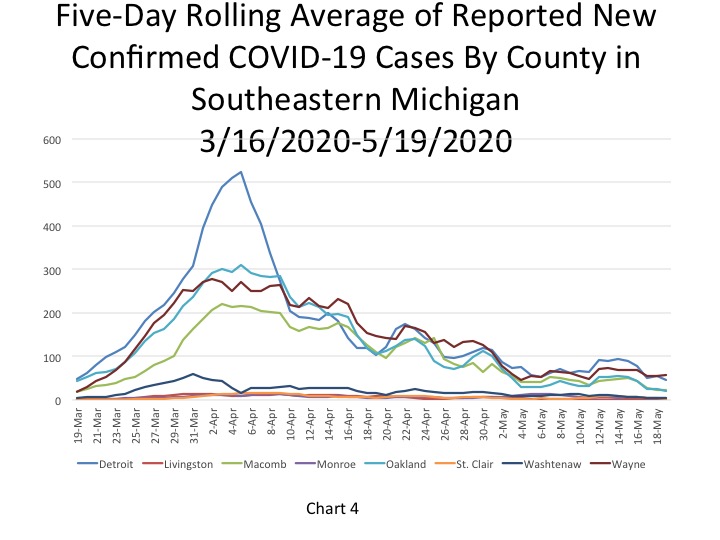
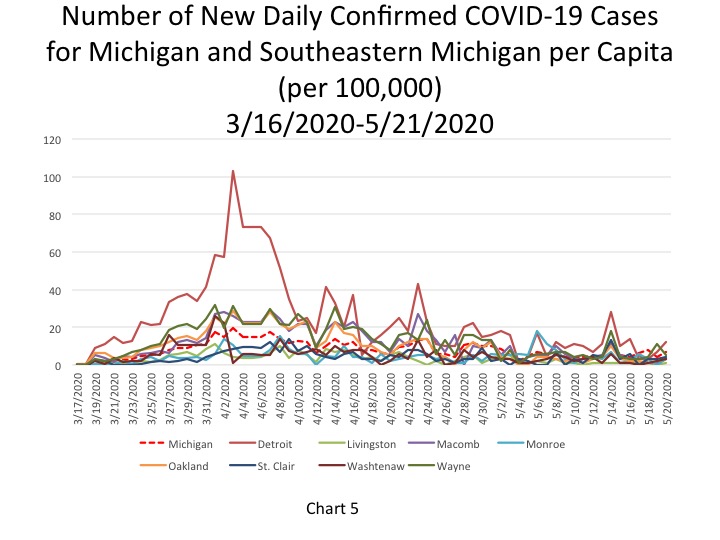
In Chart 6, the five-day rolling average for the number of deaths in Michigan shows a continuing slow increase (a lagged number of 5,002 deaths, an increase of 50 deaths). The actual reported COVID-19 on May 21 was 5,129, an increase of 69 deaths from the day prior. Of those 69 additional deaths, 31 were added to the May 21 total as result of death certificates being compared to the COVID database. Additionally, of those 69 deaths Southeastern Michigan accounted for 53 of them.
Chart 7 (a 5-day rolling average) portrays how the total number of COVID deaths in Southeastern Michigan continues to flatten, with Detroit reporting the highest cumulative number of deaths at 1,273 on May 19. Wayne County had the second highest total at 989 on May 19.
Chart 8 portrays the total number of COVID deaths per 100,000 people and as of May 21, the cumulative total of COVID deaths per 100,000 people in Detroit was 193 (representing 1,295 deaths). In Wayne County there were 95 COVID deaths per 100,000 people (1,018 total deaths), in Oakland County there were 75 deaths per 100,000 people (945 total deaths), and in Macomb County there were 88 COVID deaths per 100,000 people (772total). The State of Michigan had 51 COVID deaths per 100,000 people, which was equal to 5,129 total deaths. Detroit had the highest single day death count in Southeastern Michigan on May 21; 15 COVID deaths were reported.
In Chart 9 we see that the number of daily statewide deaths increased for the third day in a row. On May 19 the State reported 50 COVID deaths. Chart 10 shows how the number of deaths in Southeastern Michigan, except in Wayne County, have been either leveling off or decreasing. In Wayne County there was a reported 989 deaths, which was an increase of 12 from the day prior. On May 19, 12 COVID deaths were reported in Wayne County, making it the highest number of daily COVID deaths in the region. For the fifth day in a row Detroit reported 8 daily COVID deaths, further confirming that the number of deaths, at least in areas of Southeastern Michigan, are remaining stable and much lower than in previous weeks. On May 19, of the 69 new deaths reported 36 were reported out of Southeastern Michigan. These numbers are based on 5-day rolling averages.
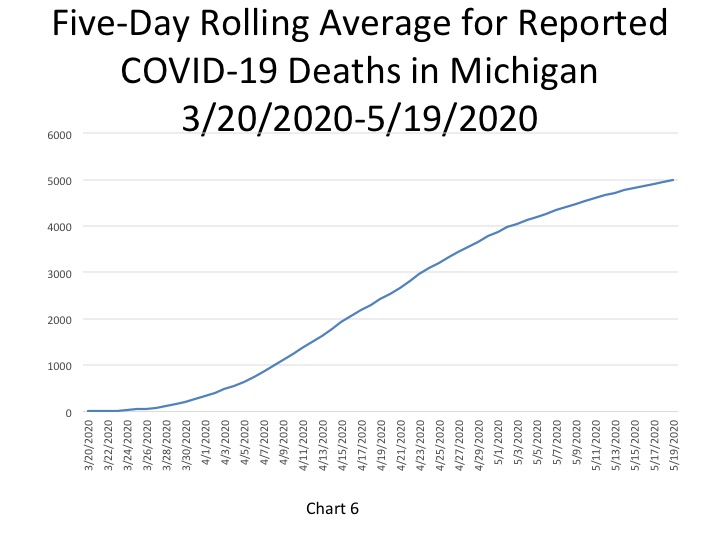
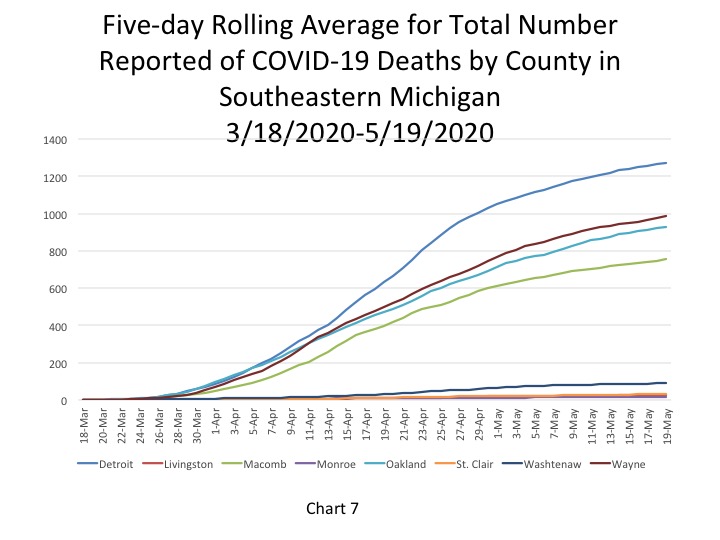
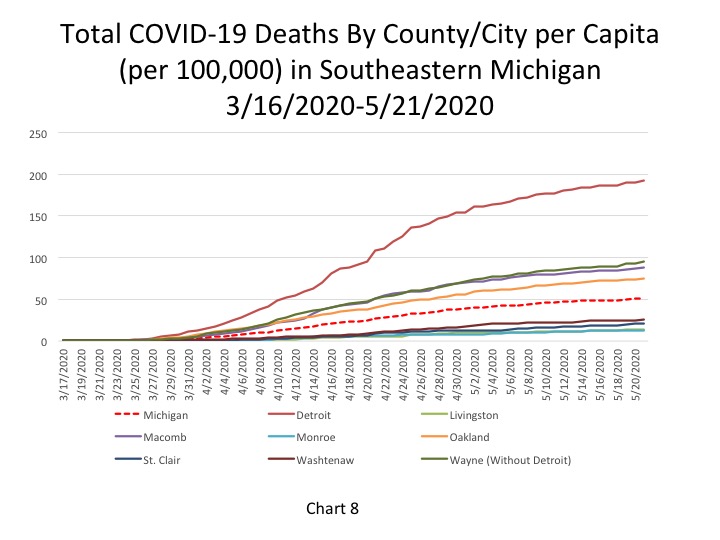
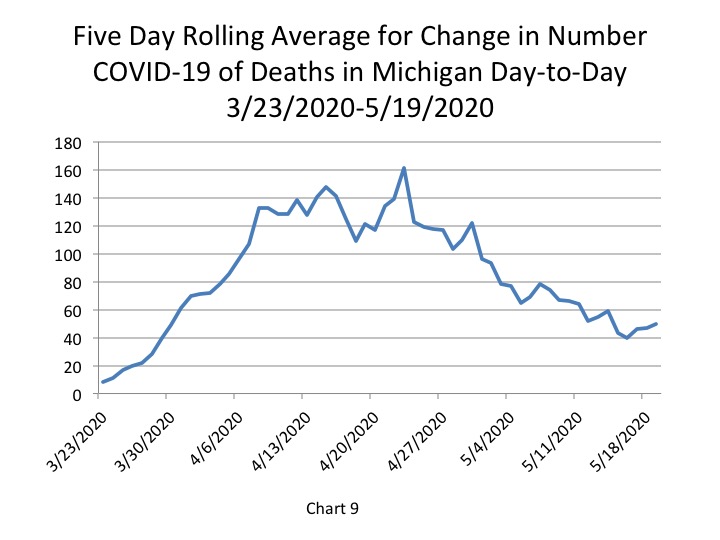
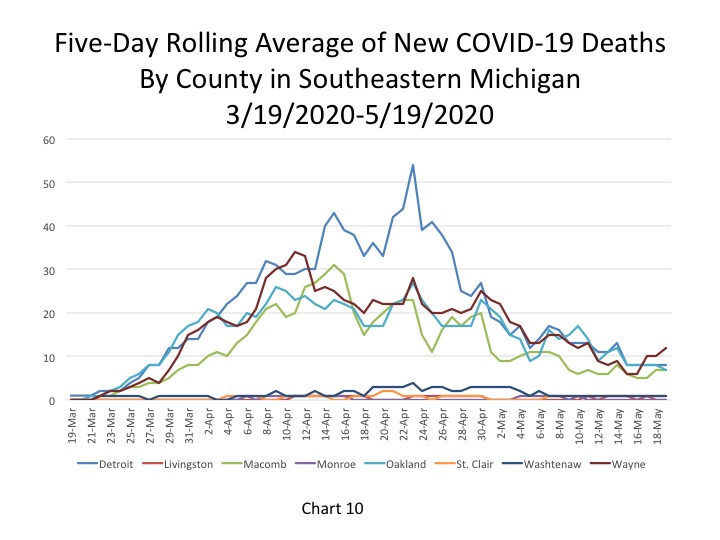
On May 21 Detroit continued to report a fatality rate of 12.2 percent, showing while it is the highest rate in the region it has leveled off. The fatality rate in Macomb County hit 12 percent for the fist time on May 21 and the State continued to report a fatality rate of 9.6 percent.
One reason we may be seeing such high fatality rates in Michigan is due to the low testing rates. When only having-presumably-a lower of number confirmed COVID cases than is actually likely due to the limited availability of tests, the fatality rate appears higher because the base comparison is smaller than it might be.
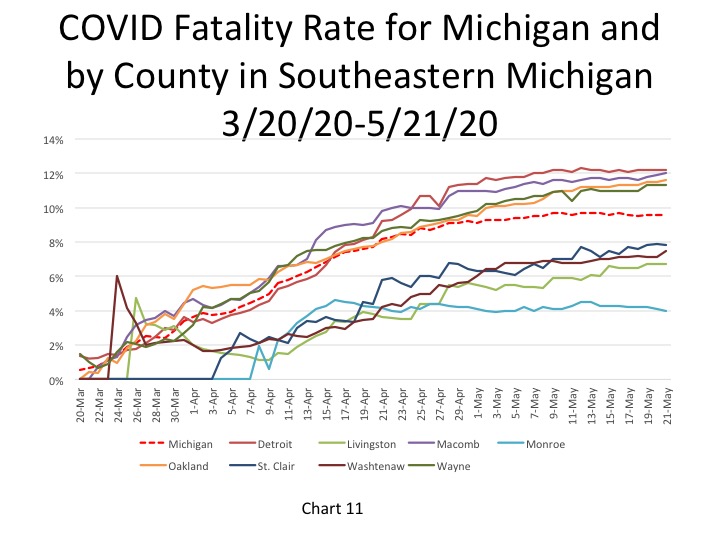
While the majority of new daily COVID cases are now being reported outside of Southeastern Michigan, our region still makes up majority of the daily COVID deaths. These numbers have dropped significantly from a month ago, but they are still concerning. Southeastern Michigan does have the largest population in the State though, and is home to several areas that have been disproportionately affected due to population density and other socioeconomic reasons.